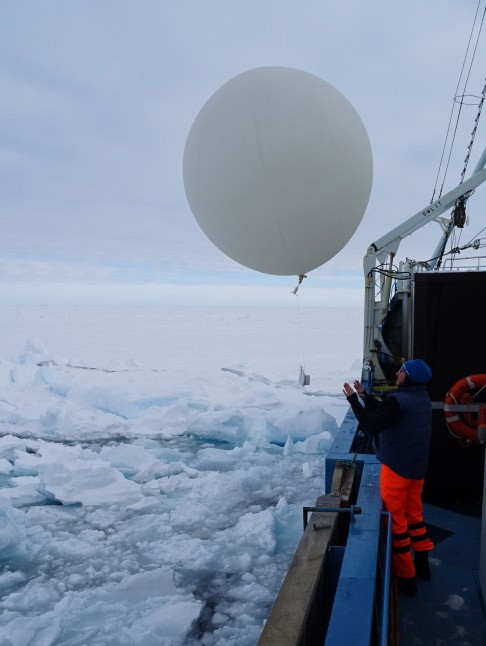Study: Newer Arctic Ice Replacing Ancient Ice Sheets Speed Up Climate Change
| Ana Verayo | | May 05, 2015 11:15 AM EDT |
(Photo : Mats Granskog / Norwegian Polar Institute) Weather balloons are launched twice a day from Lance to support climate modelling and weather forecasting.
Scientists from Norway who are now studying the Arctic sea ice believe that permanent ice sheets are now replaced by thiner, "young" ice covers that disappear during the summer season, can also apparently worsen the effects of global warming.
Researchers from the Norwegian Polar Institute believe that this event has not been observed and analyzed enough by scientists where the Norwegian government sent a ship called The Lance on a two year mission called the Norwegian Young Sea ICE Cruise.
Like Us on Facebook
This exploration involved a unique investiagation where scientists allowed their ship to become frozen with the ice near the northern Norwegian island of Nordaustlandet from Novemeber 2014 to March 2015 to monitor the ice movement.
Scientists from the U.S. National Snow and Ice Center now report that since March, the Arctic sea ice apparently decreased to its lowest level ever recorded, using satellite data.
However, the Norwegian scientists believe that this change has even more serious implications. The insitute explains that over the past 25 years, this is not just an indication of sea ice cover losses but this existing ice has been transformed into a multiyear ice system into a seasonal system.
Scientists from Norway noted that that this young, recently formed "young ice" is reflective of more solar energy at about 10 percent more than thicker ice once did. Now, half of this solar energy is absorbed by the ice which makes it melt more quickly. The other half is now absorbed by the Arctic ocean that also raises temperatures as well. This phenomenon can aggravate the rate of climate change due to the immediate ice cover changes.
Apart from this solar energy melting the ice covers and increasing ocean temperatures than normal, this temporary ice is also a threat to the biological diversity in the Arctic.
According to Norwegian biologist Haakon Hop, there is less life under the first year ice meaning multi year ice are deeper, holding more complex organisms and animal life. For example, crustaceans, amphipods and copepods' biodiversity will now dwindle including their biomass in Arctic regions that have been measured.
TagsNorwegian Young Sea ICE Cruise, Norwegian Polar Institute, The Lance, Arctic mission ship, Norway, Arctic ice sheets, Arctic ice climate change
©2015 Chinatopix All rights reserved. Do not reproduce without permission
EDITOR'S PICKS
-

Did the Trump administration just announce plans for a trade war with ‘hostile’ China and Russia?
-

US Senate passes Taiwan travel bill slammed by China
-

As Yan Sihong’s family grieves, here are other Chinese students who went missing abroad. Some have never been found
-

Beijing blasts Western critics who ‘smear China’ with the term sharp power
-

China Envoy Seeks to Defuse Tensions With U.S. as a Trade War Brews
-

Singapore's Deputy PM Provides Bitcoin Vote of Confidence Amid China's Blanket Bans
-

China warns investors over risks in overseas virtual currency trading
-

Chinese government most trustworthy: survey
-

Kashima Antlers On Course For Back-To-Back Titles
MOST POPULAR
LATEST NEWS
Zhou Yongkang: China's Former Security Chief Sentenced to Life in Prison

China's former Chief of the Ministry of Public Security, Zhou Yongkang, has been given a life sentence after he was found guilty of abusing his office, bribery and deliberately ... Full Article
TRENDING STORY

China Pork Prices Expected to Stabilize As The Supplies Recover

Elephone P9000 Smartphone is now on Sale on Amazon India

There's a Big Chance Cliffhangers Won't Still Be Resolved When Grey's Anatomy Season 13 Returns

Supreme Court Ruled on Samsung vs Apple Dispute for Patent Infringement

Microsoft Surface Pro 5 Rumors and Release Date: What is the Latest?










